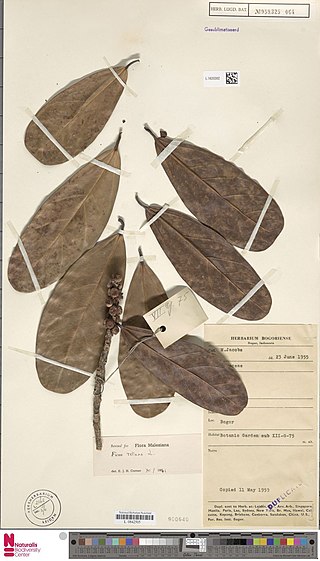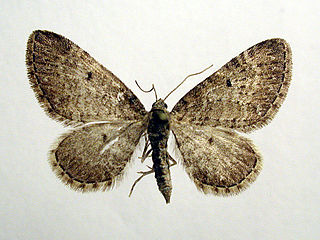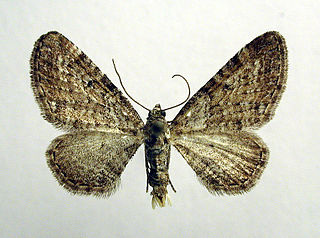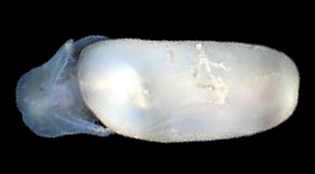
Eupithecia is the largest genus of moths of the family Geometridae, and the namesake and type genus of tribe Eupitheciini. Species in the genus are, like those of other genera in the tribe, commonly known as pugs. The genus is highly speciose, with over 1400 species, and members of the genus are present in most of the world with exception of Australasia. Roughly a quarter of described Eupithecia species occur in the Neotropical realm, where they have an especially high species diversity in the montane rain forests of the Andes. The genus includes a few agricultural pest species, such as the currant pug moth, Eupithecia assimilata, which is a pest on hops, and the cloaked pug moth, Eupithecia abietaria, which is a cone pest in spruce seed orchards.

The juniper pug or juniper looper is a moth of the family Geometridae. The species was first described by Michael Denis and Ignaz Schiffermüller in 1775. It is found throughout the Palearctic and in the Nearctic.

Ficus retusa is a species of evergreen woody plant in the fig genus, native to the Malay Archipelago and Malesia floristic region. The species name has been widely mis-applied to Ficus microcarpa.

Rhynchostylis retusa is an orchid, belonging to the Vanda alliance. The inflorescence is a pendant raceme, consisting of more than 100 pink-spotted white flowers. The plant has a short, stout, creeping stem carrying up to 12, curved, fleshy, deeply channeled, keeled, retuse apically leaves and blooms on an axillary pendant to 60 cm (24 in) long, racemose, densely flowered, cylindrical inflorescence that occurs in the winter and early spring. It is famous for its use as a hair-ornament worn by Assamese women during folk dance Bihu on the onset of spring.

Eupithecia satyrata, the satyr pug, is a species of moth of the family Geometridae. It was described by Jacob Hübner in 1813. It is found from Ireland, through northern and central Europe east to all of Russia and central Asia and western Siberia to Tibet. It is also present in North Africa and North America.

Eupithecia pernotata, or Guenée's pug, is a moth of the family Geometridae. The species was first described by Achille Guenée in 1857. It is known from the Alps, through Romania to southern Russia. It is also found in Finland.
Eupithecia albidulata is a moth in the family Geometridae. It is found in the Caucasus.

Eupithecia subbrunneata is a moth in the family Geometridae. It is found in China and Russia.
Eupithecia demetata is a moth in the family Geometridae. It is found in Turkmenistan.
Eupithecia duena is a moth in the family Geometridae. It is found in Ecuador and Peru.
Eupithecia interrubrescens is a moth in the family Geometridae. It is found in Tibet.
Eupithecia irambata is a moth in the family Geometridae. It is found in India (Sikkim).
Eupithecia junctifascia is a moth in the family Geometridae. It is found in Colombia and Costa Rica.
Eupithecia lacteolata is a moth in the family Geometridae. It is found in Russia and Turkey.
Eupithecia mejala is a moth in the family Geometridae. It is found in Ecuador, Bolivia and Peru.
Eupithecia pertacta is a moth in the family Geometridae. It is found in Mexico.
Eupithecia pilosa is a moth in the family Geometridae. It is found in Costa Rica.
Eupithecia subsequaria is a moth in the family Geometridae. It is found in Turkey.
Eupithecia undulataria is a moth in the family Geometridae. It is found in Libya.

Retusa is a genus of very small head-shield sea snails or barrel-bubble snails, marine gastropod mollusks in the family Retusidae.







